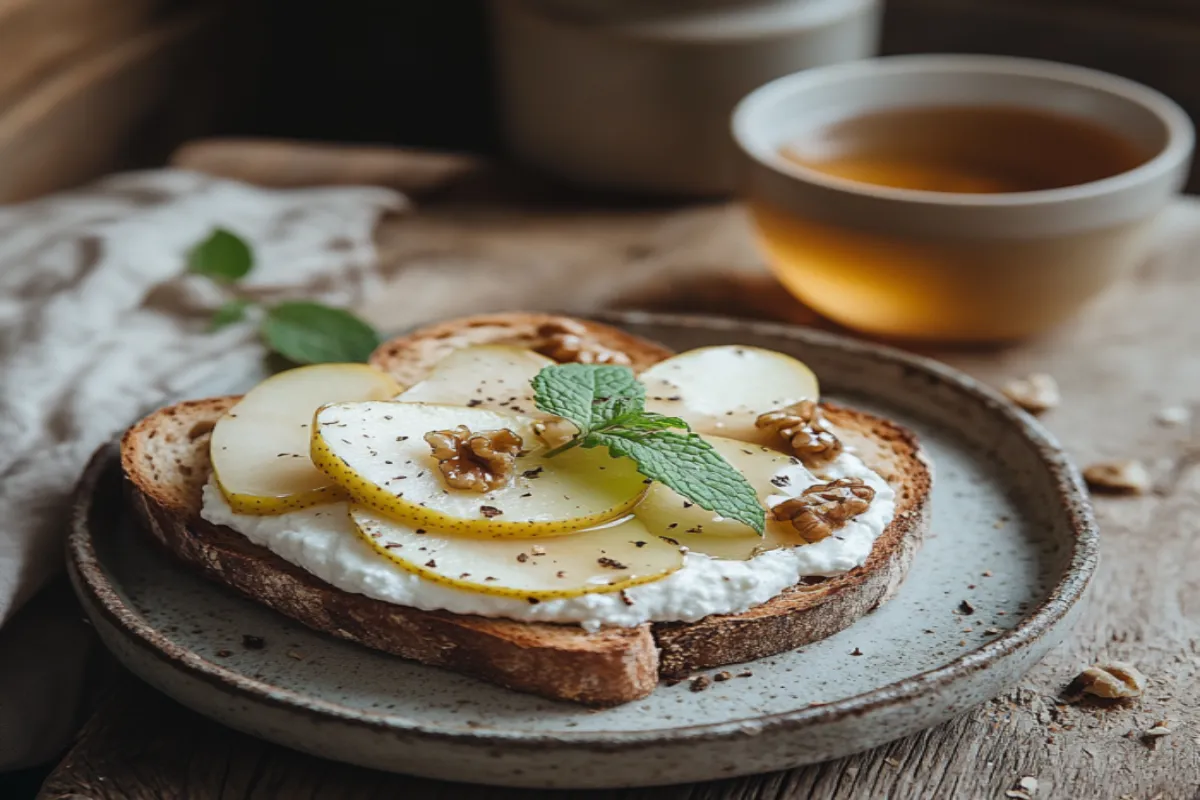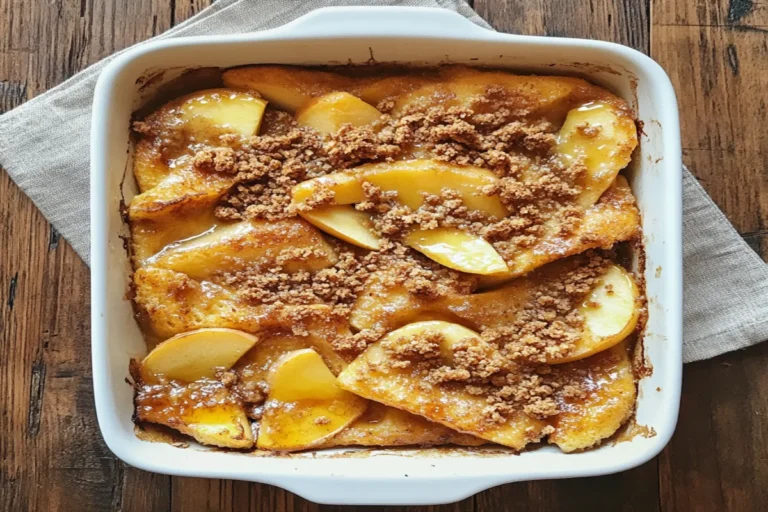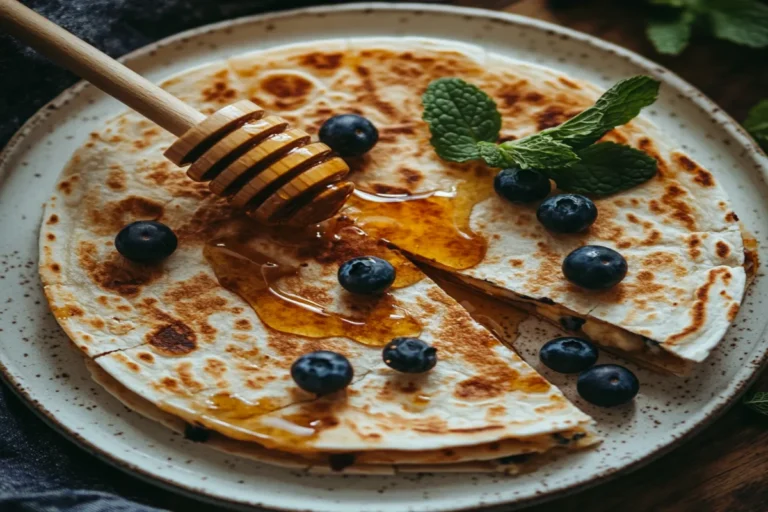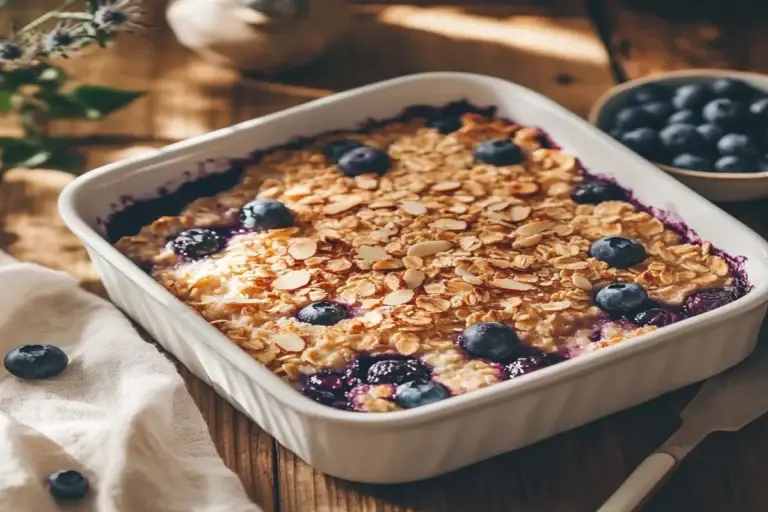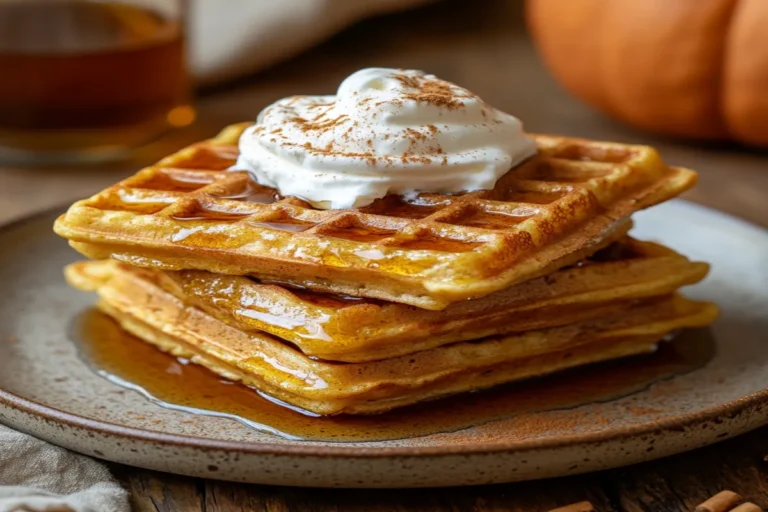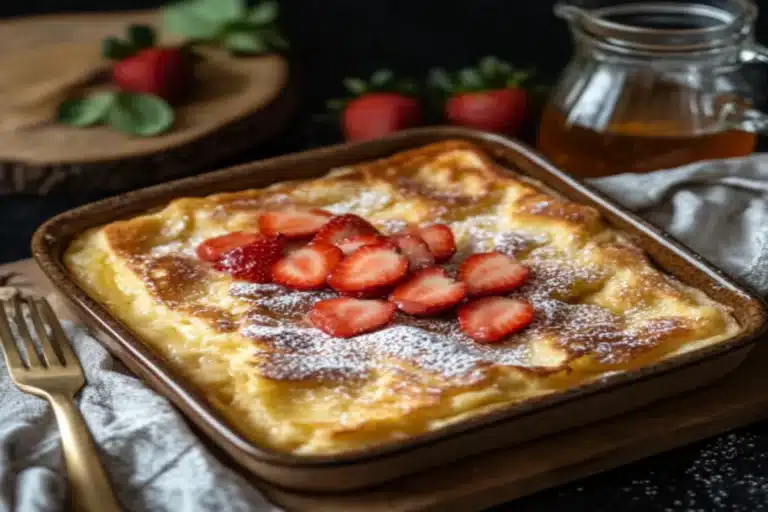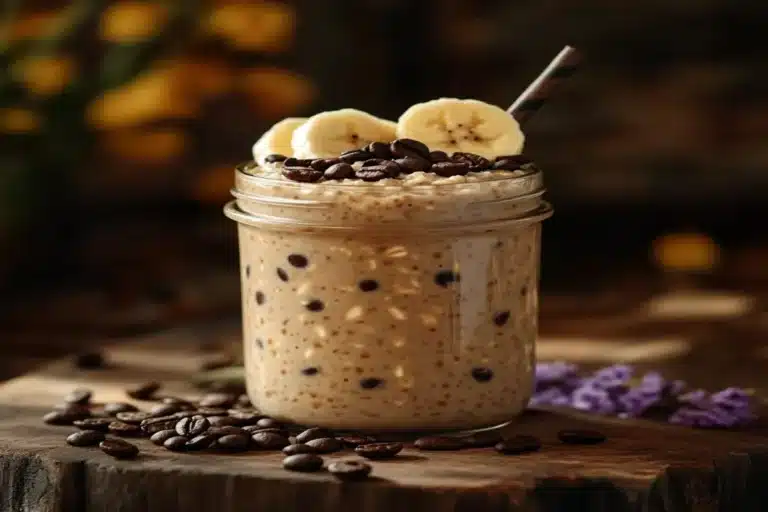Pear and Ricotta Toast with Honey & Walnuts: Delicious Breakfast recipe
Table of Contents
There’s something magical about transforming a simple piece of toast into a breakfast experience that feels worthy of a five-star hotel brunch spread. Pear and ricotta toast with honey and walnuts achieves this transformation effortlessly, elevating humble ingredients into a symphony of flavors and textures that makes every morning feel special. This isn’t just breakfast—it’s an edible meditation on how beautiful simplicity can be when executed with intention and quality ingredients.
My love affair with this particular toast combination began during a stay at a boutique bed-and-breakfast in Tuscany, where the innkeeper served this creation on thick slices of homemade sourdough as the morning sun streamed through olive trees. The first bite was revelatory—the creamy ricotta melded perfectly with the sweet, juice-laden pear slices, while toasted walnuts provided delightful textural contrast and the honey tied everything together with floral sweetness. I knew immediately that this would become more than just a vacation memory; it would become a regular part of my morning ritual.
What makes pear and ricotta toast particularly appealing is its perfect balance of sophistication and accessibility. With just five simple ingredients—quality bread, fresh ricotta, ripe pears, good honey, and crunchy walnuts—you can create breakfast that feels indulgent while actually being quite nutritious. This recipe represents the beautiful intersection of quick preparation and gourmet results, making it equally suitable for peaceful solo mornings or impressive brunch entertaining.
The Appeal of Pear and Ricotta Toast
The magic of pear and ricotta toast lies in its masterful balance of complementary flavors and contrasting textures that create a complete sensory experience with every bite. Each component contributes something essential to the overall harmony: the ricotta provides a creamy, mild foundation that doesn’t compete with other flavors; the pears offer natural sweetness and refreshing juiciness; the walnuts contribute satisfying crunch and earthy richness; while honey binds everything together with floral complexity that enhances rather than masks the other ingredients.
This flavor combination taps into something fundamentally satisfying about the interplay between sweet and savory, creamy and crunchy, mild and complex. The ricotta’s subtle tanginess provides the perfect backdrop for the pear’s natural sugars, while the walnuts add depth and richness that transforms what could be a simple sweet toast into something more sophisticated and substantial.
From a nutritional standpoint, this toast combination delivers impressive benefits that make indulgence feel virtuous. Ricotta cheese provides high-quality protein (approximately 14 grams per half-cup) along with calcium essential for bone health. Unlike many breakfast options that spike blood sugar and leave you crashing by mid-morning, the protein and fat content in ricotta help stabilize blood sugar levels and provide sustained energy.
Pears contribute valuable fiber (approximately 6 grams per medium pear), vitamin C for immune support, and potassium for heart health. Their natural sweetness satisfies morning sugar cravings without requiring refined sugars or artificial sweeteners. Walnuts provide omega-3 fatty acids crucial for brain health, along with healthy fats that enhance satiety and nutrient absorption.
The versatility of pear and ricotta toast makes it suitable for various occasions and adaptable to different preferences and dietary needs. For rushed weekday mornings, it assembles in under five minutes while providing sustained energy that carries you through to lunch. For leisurely weekend brunches, it presents beautifully on a platter and can be customized with different toppings or garnishes. The basic formula adapts easily to seasonal variations, dietary restrictions, or simply whatever ingredients you have available, making it a reliable go-to recipe that never becomes boring.
Ingredient Spotlight For Pear and Ricotta Toast
The success of exceptional pear and ricotta toast depends entirely on the quality and characteristics of its five essential components, each playing a crucial role in creating the final harmonious result.
Bread
forms the foundation that must support both literally and figuratively the toppings it carries. Not all bread works equally well for this application—you need something with enough structure to hold substantial toppings without becoming soggy, yet tender enough to provide pleasant eating texture. Sourdough excels in this role due to its sturdy crust and tangy flavor that complements the sweet toppings beautifully. The fermentation process creates a more complex flavor profile while the natural acidity helps preserve freshness.
Whole grain breads offer additional fiber and nutrients that enhance the toast’s nutritional profile while providing heartier flavor that stands up well to rich toppings. Look for breads with visible grains and seeds that add textural interest. Artisanal multigrain varieties often work particularly well, as they provide complex flavors and interesting textures without overwhelming the delicate pear and ricotta combination.
Avoid overly soft sandwich breads that become soggy quickly, or breads with strong flavors (like pumpernickel or heavily seeded varieties) that compete with the toppings. The bread should complement rather than dominate the overall flavor profile.
Ricotta Cheese
serves as the creamy canvas that unifies all other flavors while providing substantial protein and richness. Quality matters significantly with ricotta—fresh, high-quality versions have a light, fluffy texture and clean, mildly sweet flavor that mass-produced varieties can’t match. Look for ricotta with minimal ingredients (milk, vinegar or citric acid, salt) and avoid versions with stabilizers or gums when possible.
Whole milk ricotta provides the richest, most luxurious texture, while part-skim versions work well for those monitoring fat intake without significantly compromising flavor or texture. The moisture content varies between brands, so you may need to drain particularly wet ricotta briefly in a fine-mesh strainer to prevent soggy toast.
Pears
provide the starring fruit element that defines this toast’s character. Different varieties offer distinct advantages: Bartlett pears provide classic pear flavor with soft, juicy texture when ripe; Anjou pears offer firmer texture that holds up well to slicing while providing subtle sweetness; Bosc pears contribute complex flavor with hints of cinnamon and spice along with firm texture that maintains shape beautifully when sliced thin.
The ripeness level significantly impacts the final result. Ideally ripe pears yield slightly to gentle pressure at the neck but aren’t soft throughout. Overripe pears become mushy and difficult to slice, while underripe pears lack sweetness and can taste starchy.
Honey
serves as more than just a sweetener—it acts as a flavor bridge that ties all components together while adding floral complexity. Different honey varieties contribute distinct flavor profiles: wildflower honey offers complex, balanced sweetness; clover honey provides clean, mild sweetness that won’t overpower delicate flavors; orange blossom honey adds subtle citrus notes that brighten the overall profile.
Choose raw, unprocessed honey when possible, as it retains more complex flavors and beneficial compounds than heavily processed varieties. The consistency should be pourable but not thin—thick honey distributes more evenly and doesn’t make the toast soggy.
Walnuts
provide essential textural contrast and rich, earthy flavor that grounds the sweet elements. Fresh walnuts have clean, sweet flavor without any bitter or rancid notes that can ruin the entire toast. Store walnuts in the refrigerator or freezer to maintain freshness, and taste them before using to ensure quality.
Toasting walnuts briefly in a dry skillet enhances their flavor significantly while creating extra crunch that contrasts beautifully with the creamy ricotta and soft pears. Roughly chopped walnuts work better than whole halves, as they distribute more evenly and provide textural interest in every bite.
Preparing Ingredients For The Pear and Ricotta Toast
Creating consistently excellent pear and ricotta toast requires attention to ingredient selection and preparation techniques that maximize each component’s contribution to the final result.
Choosing Perfect Pears
begins with understanding ripeness indicators that ensure optimal flavor and texture. A properly ripe pear yields slightly to gentle pressure applied near the stem end, but the body should still feel firm. The skin should be smooth without dark spots or wrinkled areas that indicate overripeness. Color varies by variety, so focus on texture and aroma rather than appearance alone.
Pears ripen from the inside out, so a pear that feels soft throughout may be overripe with a mushy interior. If your pears are underripe, place them in a paper bag at room temperature for 1-3 days to accelerate ripening. Adding an apple to the bag releases ethylene gas that speeds the process further.
For this toast application, pears should be sliced just before serving to prevent browning and maintain optimal texture. Use a sharp knife to create thin, even slices (approximately ⅛-inch thick) that will lie flat on the toast. If you must slice ahead of time, brush the slices lightly with lemon juice to prevent oxidation.
Enhancing Ricotta
transforms good cheese into something exceptional through simple additions that complement the other flavors. A small amount of fresh lemon zest (approximately ½ teaspoon per cup of ricotta) brightens the flavor and adds aromatic complexity without making the ricotta taste overtly citrusy. Vanilla extract (¼ teaspoon per cup) adds subtle sweetness and depth that enhances the overall flavor harmony.
For a more sophisticated variation, try adding a pinch of freshly grated nutmeg or cinnamon, which complements the pears beautifully while adding warming spice notes. These enhancements should be subtle—the goal is to elevate the ricotta’s natural character rather than transform it into something entirely different.
Allow enhanced ricotta to sit for 10-15 minutes before using, which allows the flavors to meld and develop fully. The ricotta should be at room temperature for the best spreading consistency and optimal flavor release.
Achieving Perfect Toast
requires attention to timing and technique. The bread should be golden brown with a crispy exterior that provides structural support while maintaining a tender interior. Over-toasted bread becomes too hard and can overpower the delicate toppings, while under-toasted bread lacks the textural contrast and structural integrity needed.
Toast bread just before assembling to ensure optimal texture and temperature contrast. The warm toast helps meld the flavors while providing pleasant temperature variation against the cool ricotta and fresh pears.
Assembly Technique
affects both presentation and eating experience. Spread ricotta evenly to the edges of the toast, creating a complete foundation that prevents toppings from sliding off. The ricotta layer should be substantial enough to provide creamy richness in every bite but not so thick that it overwhelms the other components.
Arrange pear slices in an overlapping pattern that covers the ricotta completely while creating visual appeal. The overlapping technique ensures even distribution and prevents bare spots that would create unbalanced bites.
Step-by-Step Preparation Guide Of Pear and Ricotta Toast
Creating perfect pear and ricotta toast requires minimal time investment—approximately 10 minutes from start to finish—but attention to sequence and technique ensures professional-quality results.
Preparation Phase (5 minutes):
Begin by gathering all ingredients and allowing ricotta to come to room temperature if it’s been refrigerated, which takes about 15-20 minutes. Cold ricotta doesn’t spread as smoothly and provides less flavor impact than room-temperature cheese.
If enhancing the ricotta with lemon zest or vanilla, combine these ingredients in a small bowl and mix gently with a fork until evenly distributed. Set aside to allow flavors to meld while you prepare other components.
Wash and dry the pears thoroughly, then slice them just before assembly to prevent browning. Use a sharp knife to create uniform slices approximately ⅛-inch thick, discarding the core and seeds. Arrange slices on a plate in the order you’ll use them.
Roughly chop walnuts into pieces about the size of small peas—large enough to provide textural interest but small enough to distribute evenly and stay put on the toast. If desired, toast the chopped walnuts in a dry skillet over medium heat for 2-3 minutes, stirring frequently, until fragrant and lightly golden.
Toasting and Assembly (3-5 minutes):
Toast bread slices to golden brown perfection—they should be crispy on the outside but still tender within. The exact timing depends on your toaster or toaster oven settings, but generally 2-4 minutes produces optimal results.
While toast is still warm, spread ricotta evenly across each slice, extending to the edges to create a complete foundation. Use about 2-3 tablespoons of ricotta per slice, depending on the bread size. The ricotta layer should be substantial but not overwhelming.
Arrange pear slices in an overlapping pattern that covers the ricotta surface attractively. Start from one end and work across, slightly overlapping each slice to ensure complete coverage and visual appeal. Press the slices gently into the ricotta to help them adhere.
Sprinkle chopped walnuts evenly over each toast, pressing them lightly into the ricotta and pears to prevent them from falling off. The walnuts should be distributed evenly but not so densely that they overwhelm the other flavors.
Final Finishing (1-2 minutes):
Drizzle honey over each toast in a decorative pattern or simply distribute evenly across the surface. Start with a light drizzle—you can always add more, but excess honey can make the toast soggy and overly sweet. Approximately 1 teaspoon per slice usually provides the right balance.
For an elegant finishing touch, consider a light sprinkle of flaky sea salt, which enhances all the other flavors without making the toast taste salty. A tiny pinch of freshly ground black pepper can add subtle complexity that surprises and delights.
Serving Recommendations:
Serve immediately while the toast is still slightly warm, which creates pleasant temperature contrast with the cool ricotta and fresh pears. For individual servings, place each toast on a warmed plate with a sharp knife and fork alongside. For casual family breakfasts, serve on a large platter with napkins.
Complement the Pear and Ricotta Toast with freshly brewed coffee, espresso, or tea. Fresh orange juice provides a bright counterpoint to the rich flavors, while herbal teas like chamomile or mint offer gentle accompaniment that won’t compete with the delicate flavor balance.
Tips for Perfect Pear and Ricotta Toast
Achieving consistently exceptional results requires understanding several key principles that distinguish good pear and ricotta toast from truly memorable versions.
Flavor Enhancement Strategies can elevate this simple toast into something truly special. A light dusting of ground cinnamon over the assembled toast adds warming spice that complements pears naturally while providing aromatic appeal. Freshly grated nutmeg offers more complex spicing with slightly sweet, nutty notes that pair beautifully with both ricotta and pears.
For more sophisticated flavor development, try adding a few drops of vanilla extract to the honey before drizzling, which creates vanilla-honey that enhances sweetness perception while adding depth. Alternatively, infuse honey with fresh thyme or rosemary by gently warming it with the herbs for a few minutes, then straining—this creates herbaceous honey that adds unexpected complexity.
A small amount of fresh lemon juice squeezed over the assembled toast just before serving brightens all flavors and prevents pear browning. The acidity enhances sweetness perception while adding refreshing contrast to the rich ricotta.
Textural Balance Optimization ensures every bite provides satisfying variety. The key lies in achieving proper ratios: enough ricotta to provide creamy richness without overwhelming the toast, sufficient pear slices for sweetness and juiciness, and adequate walnuts for crunch without creating a dense topping.
Temperature contrast enhances the eating experience significantly. Warm toast against cool ricotta and room-temperature pears creates pleasant variety that keeps your palate engaged. If the ricotta has been refrigerated, allow it to warm slightly toward room temperature for better spreading and flavor release.
For maximum crunch, toast walnuts just before using rather than storing pre-toasted nuts, which lose their crispy texture over time. The brief toasting also releases aromatic oils that enhance flavor substantially.
Common Mistake Prevention helps avoid pitfalls that can diminish the final result. Soggy toast represents the most frequent problem, usually caused by using bread that’s too soft, applying toppings to cold toast, or using too much honey or overly wet ricotta. Choose sturdy bread, toast it properly, and drain wet ricotta briefly if necessary.
Uneven flavor distribution creates disappointing bites where one element dominates. Ensure ricotta covers the entire toast surface, distribute pear slices evenly, and sprinkle walnuts uniformly rather than concentrating them in one area.
Timing issues can affect both texture and flavor. Assemble toast just before serving to prevent sogginess and maintain optimal texture contrasts. Slicing pears too far in advance causes browning and texture degradation that diminishes the final result.
Presentation Enhancement transforms everyday toast into something special enough for entertaining. Arrange sliced pears in attractive overlapping patterns rather than random placement. Consider alternating pear slice directions or creating fan patterns for visual interest.
Garnish thoughtfully with elements that enhance rather than distract. A small sprig of fresh mint provides color contrast and aromatic appeal, while a light dusting of powdered sugar creates elegant presentation for special occasions.
Variations to Explore
The basic pear and ricotta toast formula provides an excellent foundation for countless creative variations that can adapt to different seasons, dietary preferences, or flavor cravings while maintaining the essential character that makes this combination so appealing.
Savory Transformations offer sophisticated alternatives that work beautifully for lunch or dinner applications. Adding thin slices of prosciutto creates a classic Italian flavor combination that balances the sweet pears with salty, savory richness. The prosciutto should be high-quality and sliced paper-thin to avoid overwhelming the delicate flavors.
Fresh arugula provides peppery contrast that brightens the overall flavor profile while adding nutritional value and visual appeal. Use just enough arugula to provide flavor accent without making the toast difficult to eat—typically 6-8 leaves per slice, torn into bite-sized pieces.
For a more substantial savory version, consider adding thinly sliced red onion that’s been quick-pickled in red wine vinegar for 10-15 minutes. This provides tangy sharpness that cuts through the ricotta’s richness while complementing the pears’ sweetness.
Plant-Based Adaptations accommodate vegan diets without sacrificing flavor or satisfaction. High-quality vegan ricotta alternatives work well, though the texture and flavor will differ from dairy versions. Look for brands made from cashews or almonds for the best texture and flavor approximation.
Agave nectar or maple syrup can replace honey while providing different flavor profiles—agave offers clean sweetness similar to honey, while maple syrup adds complex, caramel-like notes that complement pears beautifully.
For completely dairy-free versions, consider using thick coconut cream (the solid portion from chilled full-fat coconut milk) seasoned with a touch of vanilla and lemon zest. This creates a rich, creamy base with tropical undertones that work surprisingly well with pears and walnuts.
Seasonal Variations keep the toast interesting throughout the year by incorporating seasonal fruits and flavors that complement the basic formula. Fall versions might feature sliced apples instead of pears, with the addition of ground cinnamon and toasted pecans for warming autumn flavors.
Winter variations could incorporate dried fruits like cranberries or figs, along with warming spices like cardamom or allspice. Pomegranate seeds provide beautiful color and tart flavor that balances the sweet ricotta during winter months.
Spring versions might feature fresh berries—strawberries work particularly well—along with fresh herbs like basil or mint that provide bright, fresh flavors appropriate to the season.
Protein-Enhanced Versions work well for those needing more substantial breakfast options. Adding a thin layer of almond or peanut butter beneath the ricotta provides healthy fats and protein while creating more complex flavor profiles. Choose natural nut butters without added sugars to maintain the toast’s refined character.
Hemp seeds sprinkled over the assembled toast add protein, healthy fats, and subtle nutty flavor without significantly altering the basic character. Chia seeds provide similar nutritional benefits with less noticeable flavor impact.
International Inspirations draw from global flavor combinations to create exciting variations. Middle Eastern-inspired versions might incorporate dates instead of honey, along with pistachios instead of walnuts and a touch of orange blossom water in the ricotta.
French-inspired variations could feature pears poached briefly in white wine with vanilla and star anise, creating more complex fruit flavors that elevate the entire toast to restaurant-quality sophistication.
Mediterranean versions might incorporate fresh figs when available, along with a drizzle of high-quality balsamic reduction and toasted pine nuts for distinctly Italian flavors.
Frequently Asked Questions
Can I prepare components of this toast ahead of time for easier morning assembly?
While pear and ricotta toast tastes best when freshly assembled, several components can be prepared in advance to streamline morning preparation. Enhanced ricotta (with lemon zest or vanilla) can be prepared up to 24 hours ahead and stored covered in the refrigerator—just bring it to room temperature before using for optimal spreading consistency and flavor release. Walnuts can be chopped and even toasted several days in advance, stored in an airtight container to maintain crispness.
However, pears should be sliced just before assembly to prevent browning and maintain optimal texture. If you must slice them ahead, brush lightly with lemon juice and store covered in the refrigerator for no more than 2-3 hours. The bread should be toasted fresh for best texture, though you can have slices ready to pop into the toaster. Complete assembly should happen just before serving to prevent sogginess and maintain the textural contrasts that make this toast special.
What nuts work well as alternatives to walnuts in this recipe?
Several nuts complement the pear and ricotta combination beautifully, each bringing slightly different flavors and textures. Toasted almonds provide clean, sweet nuttiness with satisfying crunch—sliced almonds work particularly well as they distribute more evenly than whole nuts. Pecans offer buttery richness that pairs exceptionally well with pears, and their softer texture creates a different but equally appealing mouthfeel.
Pistachios provide distinctive flavor and beautiful color contrast, while hazelnuts contribute rich, almost chocolate-like notes that create more complex flavor profiles. Pine nuts work wonderfully for Mediterranean-inspired variations, offering delicate texture and subtle flavor that doesn’t compete with the other ingredients. When substituting, use roughly the same quantity as walnuts and consider toasting briefly to enhance flavor and texture, regardless of which nut you choose.
Are there good substitutes for ricotta cheese that maintain similar texture and flavor?
Several alternatives can work depending on your specific needs and flavor preferences. Mascarpone provides similar creamy texture with richer, slightly sweeter flavor—use slightly less than you would ricotta as it’s denser and more intense. Cream cheese works well when softened to room temperature, though its tangy flavor is more pronounced than ricotta’s mild character.
For lighter alternatives, thick Greek yogurt (strained overnight to remove excess liquid) provides similar protein content with tangier flavor and less richness. Cottage cheese can work if blended until smooth, though the texture won’t be quite as silky as ricotta. For those avoiding dairy, high-quality vegan ricotta alternatives made from cashews or almonds provide the closest approximation to traditional ricotta’s texture and mild flavor, though the taste will be noticeably different. Whichever substitute you use, consider the flavor impact and adjust other seasonings accordingly.
How can I prevent the toast from becoming soggy when assembled?
Preventing soggy toast requires attention to several key factors throughout the preparation process. First, ensure your bread is toasted to proper crispness—golden brown with a firm exterior that can support moist toppings. Under-toasted bread lacks the structural integrity needed, while over-toasted bread can be too hard and brittle.
Use ricotta at room temperature, which spreads more easily and requires less manipulation that might tear the toast. If your ricotta seems particularly wet, drain it briefly in a fine-mesh strainer to remove excess moisture. Apply honey judiciously—start with less than you think you need, as you can always add more. Use the gentlest drizzle possible rather than pooling honey in one area.
Assemble the toast just before serving rather than allowing it to sit, and serve on warmed plates to help maintain temperature contrast. If you must hold assembled toast briefly, place it on a wire rack rather than a solid surface, which allows air circulation and prevents moisture from accumulating underneath.
Conclusion
Pear and ricotta toast with honey and walnuts represents the beautiful simplicity that makes exceptional food so memorable—proof that the most satisfying meals often come from treating simple, quality ingredients with respect and attention. This recipe embodies the principle that breakfast can be both nourishing and luxurious, quick and sophisticated, healthy and utterly satisfying.
The versatility of this combination means it will never grow stale in your morning rotation. Whether you prefer the classic version that celebrates each ingredient’s natural character or enjoy exploring the many variations that adapt to seasons, dietary needs, or flavor cravings, you’re creating breakfast experiences that start each day on a note of mindful indulgence.
Beyond its immediate pleasures, this toast represents a philosophy of eating that prioritizes quality over quantity, mindfulness over convenience, and genuine nourishment over empty satisfaction. In our rushed world, taking a few minutes to assemble something beautiful and delicious becomes an act of self-care that sets a positive tone for whatever challenges the day might bring.
What variations are you most excited to try? Have you discovered other fruit and cheese combinations that work well on toast? We’d love to hear about your creative experiments and personal adaptations in the comments below. Your discoveries might inspire other readers to explore new flavor territories they hadn’t considered.
For more recipes that celebrate the art of simple sophistication—breakfast dishes that prove healthy eating is delicious eating—subscribe to our newsletter. Each week, we share new ideas for transforming everyday ingredients into extraordinary experiences, from energizing breakfasts to satisfying dinners and everything in between. Join our community of food enthusiasts committed to exploring how thoughtful cooking can enhance both health and happiness.
What will your first pear and ricotta toast creation look like?

